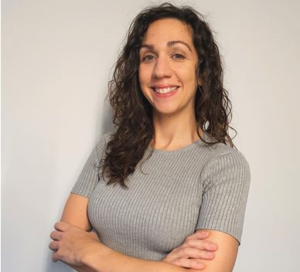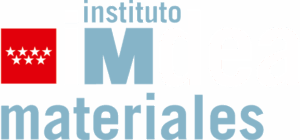 Dra. Eva Moreno was born in Toledo, Spain. She joined IMDEA Materials in 2009, where she completed her PhD thesis entitled “Formability of ultra-fine grained metallic materials” under the supervision of Dr. Ilchat Sabirov. Afterwards, she found a position as a metallurgist in the materials laboratory of Siemens Wind Power in Denmark. Currently, she is the Head of the Materials Laboratory at Siemens Gamesa Renewable Energy in Denmark.
Dra. Eva Moreno was born in Toledo, Spain. She joined IMDEA Materials in 2009, where she completed her PhD thesis entitled “Formability of ultra-fine grained metallic materials” under the supervision of Dr. Ilchat Sabirov. Afterwards, she found a position as a metallurgist in the materials laboratory of Siemens Wind Power in Denmark. Currently, she is the Head of the Materials Laboratory at Siemens Gamesa Renewable Energy in Denmark.
To begin this interview, we would like to know how your scientific vocation was born and in which institutions you have studied.
I do not have a clear memory of when my scientific vocation started. Neither had I a clear target of becoming a scientist. Nevertheless, I recalled that math and science were my favourite subjects in school. Continuing on the technical path, I enrolled on Industrial Engineering at the University of Castilla La Mancha. It was then when I discovered the intriguing world of materials science. Special mention deserves my dear Dr. Gloria Patricia Rodriguez and Dr. Gemma Herranz that introduced me to the use of concentrated solar energy in the surface treatment of steels. At that moment, I was putting an end to my bachelors and deciding which path I would take. Doing my bachelor final thesis in the lab of the materials department was an eye-opener that led me to do the PhD in material science and engineering and, later on, to work in the renewable energy field as a materials expert.
You did your PhD at the IMDEA Materials Institute. Can you tell us why you chose IMDEA? Besides that, could you tell us a bit about you and your experience and how your PhD here has helped you in your professional career?
I chose IMDEA because I found it an excellent opportunity to keep learning and thus grow as a professional scientist. IMDEA’s investigation lines were and still are interdisciplinary within the materials science field; from laboratory testing to simulation and modeling, from metallic materials to composites and carbon-based materials, etc. One of the strengths of IMDEA Materials is that it facilitated a platform for knowledge sharing and collaboration among colleagues not only internally but also externally with other important research institutions. The institute became an emblem for research and innovation within the scientific world, and that, as I believe, is because of the passion and proximity of the scientists and the technicians of IMDEA Materials.
The institutions leave a mark on people. What do you value most about your stage at IMDEA Materials from a personal point of view?
I can firmly say that the connections I built with other students, researchers and technicians are the most valued outcome from my stage at IMDEA Materials. I should of course mention Dr. Ilchat Sabirov, who, as my mentor and Ph.D thesis director, was very supportive and committed. I will be always very grateful to his guidance. There are great professionals working in IMDEA, and specially, still some friends.
What did you do after you finished your PhD at IMDEA Materials?
After finishing my PhD, I felt that I could contribute to the change that our planet needs. Still motivated for working on innovation, I packed my luggage, moved to Denmark and joined the Materials Laboratory in Siemens Wind Power (now Siemens-Gamesa Renewable Energy) as a metallurgist. It was my dream job! I could still work on materials engineering, use microscopes and apply all I learnt during my studies to the industry! In green energy! What else could I dream of? During my time as metallurgist, I faced the most interesting and exciting challenges in my career as the most significant part of my job consisted of material characterization for development projects and root cause failure analysis of the main metallic components of the wind turbines.
Nowadays, I am the head of the Materials Laboratory in Siemens-Gamesa Renewable Energy. The laboratory was founded mainly as a support function to the entire organization. We give support not only to our colleagues solving warranty cases but also to our designers and testing engineers. We are an international team of very skilled technicians and specialists within the materials field. We have also a key role in external and internal R&D projects that allows us to be at the cutting-edge of technology.
How valuable are the skills you obtained during your Ph.D. and which other ones you feel missing now that you have some perspective about it for your current position?
My first job after the PhD required a very technical background which I obtained during my bachelors and PhD. Even though my job as metallurgist was not focused on academic research, all the skills that I developed during my stage at IMDEA were of great help; from being able to use light and electron microscopy and other different characterization techniques that I used on a daily basis up to the present and the ability to defend technical reports in front of customers and suppliers.
Nowadays, I could say that my experience in the lab helps me to manage not only a team of experts in the field but also the R&D projects that we work on. However, I feel that I still have a lot to learn in this new world to become the manager I would like to be.
How different do you think it is working in the industry with respect to doing academic research?
There is a big difference, I cannot deny that. Mainly, the tight deadlines for the project deliveries make the specialists not being able to investigate in so much detail as if they were doing academic research. I can say in behalf of all my colleagues that there are many interesting topics that we would love to deep dive, but unfortunately, we do not have the time for it. Specially in the wind industry, the technology evolves extraordinarily fast to be the market lead. Most industrialized countries have a strategy for replacing their fossil fuel energy supply with wind power and solar power; and the pace is high: today fossil fuel and nuclear power amounts to 68% of the global power generation. By 2040 this number will be reduced to 50%. Whereas the wind market is booming, it is equally true that the competition has never been fiercer. New models of wind turbines are continually being developed to be able to produce as much energy as possible and in the most efficient ways and at the lowest cost. That puts significant time pressure in the testing and development stages of our wind turbines. On a more positive note, working in an industry such as wind power generation contributes to having a broader overview of technology development with both worlds of engineering and materials strongly interrelated. And last but not least, in the lab, we might not be able to investigate materials in depth, but truth be said, we focus on a significantly high variety of materials, which expands our general knowledge.
What career advice or message would you give to PhD students or early post-docs?
I believe that the scientific career requires passion and commitment. There may be times when the results are not the expected ones. My advice is to be resilient when difficulties arise. It is essential to establish a good communication with supervisors and colleagues that will contribute to find solutions together. I believe that in the scientific world, cooperation and connections are key factors. Having a good open communication with colleagues and experts will always make the way less troubled. Being supported and support others is essential for success.
How do you see the future of research for current students in the field of materials?
I think one of the biggest challenges for the current industry is in general, to produce high quality products at low cost. I can mainly talk based on my own experience, reducing the levelized cost of energy will contribute to the development and implementation of green energy. The introduction of new materials and manufacturing processes that can help to reduce the cost but, at the same time, increase the efficiency of renewable energy generation is simply fascinating, and it has excellent potential for research and development

